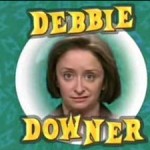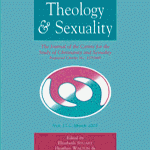I believe that staying in trouble is an important ethical practice. But, what do I mean by this? What sort of resources do we have for understanding how staying in trouble should be practiced? In this entry, I want to reflect on an important way in which my own thinking is different from Judith Butler’s: While Butler argues that grief is a valuable resource for staying in trouble, it is not the only resource. As someone who has spent the last 4 years grieving for a mother who was dying (and who died on September 30th of this year) of a particularly horrific form of cancer (pancreatic), I am not interested in mining the ethical/transformative possibilities of grief. I don’t want to keep grieving; I want to stop grieving and I want to think about what other resources we have for staying in trouble. What about humor and comedy? Are there ways to think about the state of being in trouble that are not connected to violence, grief and vulnerability (as something that is only negative and that always signals loss–of control, of autonomy, of stability)?
In many of her recent works, such as Undoing Gender, Precarious Life and Frames of War: When is Life Grievable?, Butler focuses on the importance of grief. In Precarious Life, Butler asks:
Is there something to be gained from grieving, from tarrying with grief, from remaining exposed to its vulnerability and not endeavoring to seek a resolution for grief through violence? If we stay with the sense of loss, are we left feeling only passive and powerless, as some might fear? Or are we, rather, returned to a sense of human vulnerability, to our collective responsibility for the physical lives of one another?
And concludes:
To foreclose the vulnerability, to banish it, to make ourselves secure at the expense of every other human consideration is to eradicate one of the most important resources from which we must take our bearing and find our way (30).
Refusing to leave our grief, where we are beside ourselves with sadness and pain, can be very productive for us; it reminds us how we are connected to others and it can make us more compassionate as we are compelled to recognize our own vulnerability. Grief—the loss of a loved one—undoes us. We can no longer believe in the illusion that we have control and that we are autonomous individuals who act freely and without constraint. When we grieve it is not that we suddenly become vulnerable. Instead, the belief that we are not vulnerable and the illusions that we construct to shore up that belief no longer work. Grief reminds us (or perhaps enlightens us) that we have always already been vulnerable. I agree that there is something extremely valuable about being compelled to face our own vulnerability; it can open us up to thinking about, respectfully listening to, and valuing the lived experiences of others.
We can understand Butler’s promotion of grief to be functioning in three different ways in her texts. First, Butler is particularly interested in valuing grief because public displays of grief and the right to grieve for those you love have been denied lots of folks within gay/lesbian/queer/trans communities (here, she is thinking about the AIDS crises and how so many folks were not able to publicly grieve for those that they lost to the illness). So, when she promotes grief, she is thinking about these communities and their important need—what she might even call their human right—to have their love and grief publicly acknowledged and respected. Second, she wants to value grief in post 9/11 America because it was so quickly foreclosed in order to violently respond to the attacks on September 11th. Instead of reflecting on what happened and allowing our grief to open us up to the world, the Bush regime swiftly turned to violent retribution. This lack of a space for grief made it very difficult for us to critically reflect on our grief. And the specific way in which we responded to the attack, through a politics of terror, anti-intellectualism, the production of the Arab-as-terrorist-abject, and the development of a policy of Us vs. Them, encouraged us to dehumanize (and not grieve) for any of those victims who we deemed to be not like us. In both of these instances, the specific ways in which grief has been foreclosed has been very violent. I find Butler’s desire to alleviate that violence through valuing grief to be very compelling.
These first two ways are in response to specific historical, cultural, social conditions. In these situations grief is the thing needed because grief has been so unjustly denied. But, there is a third way to understand what Butler is doing with grief. If we trace her work back through Gender Trouble, Psychic Life of Power and even Precarious Life, we see that she is promoting grief as a valuable state to be in as a subject. Her emphasis on not foreclosing grief is the idea that being in a state of grief, where we are undone and are forced to recognize that undone-ness, is “one of the most important resources from which we must take our bearing and find our way” (30). So, grief is fundamental to our experiences (and our effectiveness) as subjects.
 Now, is Butler really suggesting that we should all try to stay in a state of grief all of the time? I don’t think so. But, what are to make of her claim that it is one of our most valuable resources, especially when she offers no other resources? I agree with Butler that being undone, that recognizing our vulnerability, is essential. But, I have become increasingly tired of talking about grief. Staying in a state of vulnerability-as-grief (like I have with my mom) for such a long time is too much for anyone. It is an important resource (my own experiences in grief have opened me up to more ways of being/doing), but it should never be the only resource. And, it should not be the model for how to recognize our fundamental connection and accountability to others and how to stay in trouble. Where is the laughter (and the fun) that Butler argued for in Gender Trouble? It seems to me that Butler’s overemphasis on grief has turned her into a Debbie Downer. (Yes, I am referring to the character on Saturday Night Live who is played by Rachel Dratch. I must write more about her and the laughter that accompanies her depressing rants. How do humor and grief work simultaneously in these sketches?)
Now, is Butler really suggesting that we should all try to stay in a state of grief all of the time? I don’t think so. But, what are to make of her claim that it is one of our most valuable resources, especially when she offers no other resources? I agree with Butler that being undone, that recognizing our vulnerability, is essential. But, I have become increasingly tired of talking about grief. Staying in a state of vulnerability-as-grief (like I have with my mom) for such a long time is too much for anyone. It is an important resource (my own experiences in grief have opened me up to more ways of being/doing), but it should never be the only resource. And, it should not be the model for how to recognize our fundamental connection and accountability to others and how to stay in trouble. Where is the laughter (and the fun) that Butler argued for in Gender Trouble? It seems to me that Butler’s overemphasis on grief has turned her into a Debbie Downer. (Yes, I am referring to the character on Saturday Night Live who is played by Rachel Dratch. I must write more about her and the laughter that accompanies her depressing rants. How do humor and grief work simultaneously in these sketches?)
So, what about playfulness, laughter, and joy? What sort of resource does humor serve as? How might laughter and humor enable us to connect with others and open ourselves up to those others? Why does trouble seem to lead directly (and exclusively) to tragedy, violence and being undone? As I continue to ponder the ethical value of troublemaking and troublestaying, I want to focus on the joyful, playful and fun (sometimes, but not always, funny) resources for living a virtuous life. This focus is not meant to deny the existence of grief (indeed, it is something that, for good or bad, I live with now), but to suggest that trouble isn’t always negative and that our practices of it may yield positive (dare I say, happy?) results.

